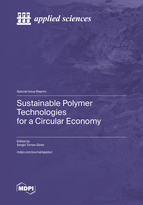Sustainable Polymer Technologies for a Circular Economy
A special issue of Applied Sciences (ISSN 2076-3417). This special issue belongs to the section "Applied Industrial Technologies".
Deadline for manuscript submissions: closed (10 February 2023) | Viewed by 41799
Special Issue Editor
Interests: bio-based and biodegradable polymers; green composites; polymerization of biopolymers; processing of bioplastics; nanofibers obtained by electrospinning; sustainable polymer technologies for food preservation; controlled release of active compounds in plastic formulations; biopolymers for food packaging; bioeconomy; circular economy
Special Issues, Collections and Topics in MDPI journals
Special Issue Information
Dear Colleagues,
We live in a defining moment in history, a moment where the scientific community has come together to agree on an ambitious framework to resolve the environmental issues associated with plastic waste. Plastics are the “workhorse” material of the modern economy, with multiple functions that help to tackle a number of the challenges facing our society. Plastic production has increased from 15 million tons in the sixties to 311 million tons in 2014 and is expected to triple by 2050, as plastics come to serve increasingly more applications. Plastic packaging is and will remain the dominant sectoral use of plastics globally, representing nearly 40% of the plastic market. However, after a first short use cycle, most of its value is lost to the economy. Furthermore, hundreds of millions of tons of plastics escape collection systems, ending up in the environment whether as microscopic particles or surviving in a recognizable form for hundreds of years. Therefore, it is high time to implement the Circular Economy principles in the plastic sector. The game-changing strategy is to promote sustainable polymer technologies that decouple plastics from fossil feedstocks, drastically reduce the leakage of plastics into natural systems, and increase the quality and uptake of plastic recycling. This Special Issue focuses on recent research studies devoted to enabling better economic and environmental advances in the plastic packaging value chain that can successfully accelerate the transition of the plastic industry from its traditional linear economy to a more valuable and sustainable model.
Prof. Dr. Sergio Torres-Giner
Guest Editor
Manuscript Submission Information
Manuscripts should be submitted online at www.mdpi.com by registering and logging in to this website. Once you are registered, click here to go to the submission form. Manuscripts can be submitted until the deadline. All submissions that pass pre-check are peer-reviewed. Accepted papers will be published continuously in the journal (as soon as accepted) and will be listed together on the special issue website. Research articles, review articles as well as short communications are invited. For planned papers, a title and short abstract (about 100 words) can be sent to the Editorial Office for announcement on this website.
Submitted manuscripts should not have been published previously, nor be under consideration for publication elsewhere (except conference proceedings papers). All manuscripts are thoroughly refereed through a single-blind peer-review process. A guide for authors and other relevant information for submission of manuscripts is available on the Instructions for Authors page. Applied Sciences is an international peer-reviewed open access semimonthly journal published by MDPI.
Please visit the Instructions for Authors page before submitting a manuscript. The Article Processing Charge (APC) for publication in this open access journal is 2400 CHF (Swiss Francs). Submitted papers should be well formatted and use good English. Authors may use MDPI's English editing service prior to publication or during author revisions.
Keywords
- Plastics towards a Circular Economy
- Biopolymers
- Green composites
- Natural additives for plastic formulations
- Waste management of plastics
- Biorefinery system design
- Reduction of plastic packaging leakage
- Chemical and physical recycling
- Compostable plastic articles
- Sustainable packaging






